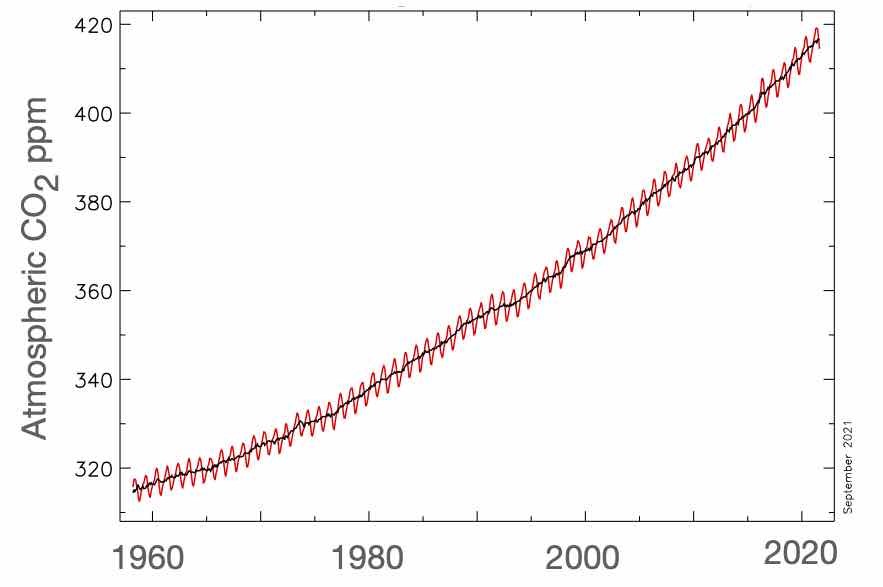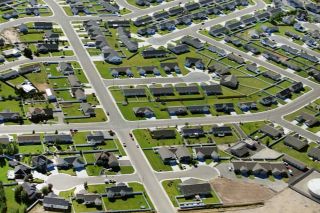
www.buildingsandcities.org/insights/commentaries/cop26-illusions.html
COP-26: Stopping Climate Change and Other Illusions

By William E. Rees (Professor Emeritus, University of British Columbia, CA)
Do not expect significant progress from COP-26 on climate change mitigation. There are fundamental barriers that prevent the deep and rapid changes that scientists advocate. Most countries adhere to economic growth policies - which create ecological overshoot. Unless and until we accept that we must live within ecological limits, then climate change will not be adequately tackled. Energy and resource consumption must be addressed through controlled economic contraction.
The world in 2021 was buffeted by an unprecedented barrage of extreme weather events. This is the leading edge of the climate catastrophe that lies ahead should world governments remain fixed on our present global 'development' trajectory.
The good news is that the recent uptick in violent weather has increased pressure on participants in COP-26 finally to implement the kind of determined measures that will dramatically lower GHG emissions and put global heating on hold; the bad news is that whatever is agreed to at COP-26 is unlikely to make any positive difference.
There have been 25 COP meetings on climate change since 1995 and several international agreements to reduce carbon emissions, including the 'legally binding' 1997 Kyoto Protocol and the Paris Agreement of 2015. Nevertheless, atmospheric GHG concentrations have increased unabated during this entire 25 year period - CO2, the principal anthropogenic GHG, has ballooned exponentially from ~360ppm in 1995 to almost 420 ppm in 2020 - and mean global temperature has risen by ~1 oC. History suggests that what should emerge from COP26 cannot emerge from COP26.
There are two fundamental barriers. First, participants in the COP meetings - government negotiators, political and scientific advisors, etc. - constitute a self-referencing cabal whose 'solutions' to climate change draw on the same set of beliefs, values, assumptions and facts that created the problem in the first place. In particular, they are dedicated to unconstrained economic growth propelled by continuous technological development, the beating heart and lungs of capitalism and neoliberal economics. Acceptable approaches to emissions reductions therefore include wind turbines, solar photovoltaic panels, hydrogen technologies, electric vehicles and as yet unproved carbon capture and storage technologies - i.e., any solution that involves the massive capital investment and profit-making potential necessary to sustain growth and the current socio-economic system.
My expectation is that COP26 will maintain the tradition. The latest emissions reduction strategy advanced by many COP participants is Net Zero 2050. NZ2050 implies achieving a balance between carbon emissions and extractions from the atmosphere by mid-century. Indeed, climate models already depend on so-called negative emissions technologies, particularly 'bio-energy with carbon capture and storage' (BECCS), to achieve the Paris target of limiting global heating to under 1.5 oC.
BECCS assumes we can gradually displace fossil fuels by growing biofuel crops to extract large quantities of CO2 from the atmosphere, and then capture and sequester the CO2 emitted when the biomass is burned. The problem is that BECCS is as yet unproved at scale and highly controversial. For one thing, the massive cropland requirement would generate crisis-level conflict with both food production and biodiversity conservation. Some climate scientists see NZ2050 as yet another in a series of "magical yet unworkable" technical (non)solutions to the climate conundrum (Dyke et al., 2021). They argue that the idea of net zero simply continues what has proved to be a "recklessly cavalier 'burn now, pay later' approach" which has seen carbon emissions continue to soar. Spratt and Dunlop (2021) characterize NZ2050 as "not just a goal, but a strategy for COP-26 to lock in many decades of unnecessary fossil fuels use well past 2050... [and creating] unacceptable risks of unstoppable climate warming." These characterizations depict a world in desperation, willing to risk catastrophic climate change in service of a perceived need to maintain growth-oriented business-as-usual-by-alternative-means. Perversely, then, mainstream climate disaster policy seems designed to serve modern techno-industrial society and the capitalist growth economy so the latter appears to be "the solution to (not the cause of) the [problem]" (Spash, 2016, p. 931).
Second, climate change is not even the real problem; ecological overshoot is (Rees, 2020). 'Overshoot' occurs when humanity consumes bio-resources faster than ecosystems can regenerate and waste production exceeds nature's assimilative capacity (see GFN, 2021). In effect, the growing human enterprise is literally consuming and polluting the biophysical basis of its own existence.
Overshoot is a meta-problem: climate change; plunging biodiversity; pollution of land, air and waters; tropical deforestation; soil/land degradation etc., etc., are all co-symptoms of overshoot. Climate change is an excess waste problem - CO2 is the greatest waste by weight of modern techno-industrial (MTI) economies. We cannot solve any major symptom of overshoot in isolation. Indeed, the mainstream approach to emissions reductions will not only fail to subdue climate change but, by promoting material growth, will exacerbate overshoot (Seibert and Rees, 2021). On the other hand, if we eliminate overshoot we simultaneously relieve its various symptoms. The problem is, the only way to eliminate overshoot is, by definition, through some combination of absolute reductions in energy and material consumption and smaller populations, i.e., through controlled economic contraction.
This is why we cannot expect COP-26 to address the human eco-predicament.
References
Dyke, J., Watson, R. & Knorr, W. (2021). Climate scientists: concept of net zero is a dangerous trap. The Conversation (22 April 2021), https://theconversation.com/climate-scientists-concept-of-net-zero-is-a-dangerous-trap-157368
GFN. (2021). Media Backgrounder: Earth Overshoot Day. Global Footprint Network, https://www.overshootday.org/newsroom/media-backgrounder/
Rees, W.E. (2020). Ecological economics for humanity's plague phase. Ecological Economics, 169 (March 2020), https://doi.org/10.1016/j.ecolecon.2019.106519
Seibert, M.K. and Rees, W.E. (2021). Through the eye of a needle: an eco-heterodox perspective on the renewable energy transition. Energies 14(15): 4508, https://doi.org/10.3390/en14154508
Spash, C. (2016). This changes nothing: the Paris Agreement to ignore reality. Globalizations, 13(6), 928-33.
Spratt, D. and Dunlop, I. (2021). "Net zero 2050": a dangerous illusion. Breakthrough Briefing Note (July 2021), https://52a87f3e-7945-4bb1-abbf-9aa66cd4e93e.filesusr.com/ugd/148cb0_714730d82bb84659a56c7da03fdca496.pdf
Latest Peer-Reviewed Journal Content
A framework for 1.5°C-aligned GHG budgets in architecture
G Betti, I Spaar, D Bachmann, A Jerosch-Herold, E Kühner, R Yang, K Avhad & S Sinning
Net zero retrofit of the building stock [editorial]
D Godoy-Shimizu & P Steadman
Co-learning in living labs: nurturing civic agency and resilience
A Belfield
The importance of multi-roles and code-switching in living labs
H Noller & A Tarik
Researchers’ shifting roles in living labs for knowledge co-production
C-C Dobre & G Faldi
Increasing civic resilience in urban living labs: city authorities’ roles
E Alatalo, M Laine & M Kyrönviita
Co-curation as civic practice in community engagement
Z Li, M Sunikka-Blank, R Purohit & F Samuel
Preserving buildings: emission reductions from circular economy strategies in Austria
N Alaux, V Kulmer, J Vogel & A Passer
Urban living labs: relationality between institutions and local circularity
P Palo, M Adelfio, J Lundin & E Brandão
Living labs: epistemic modelling, temporariness and land value
J Clossick, T Khonsari & U Steven
Co-creating interventions to prevent mosquito-borne disease transmission in hospitals
O Sloan Wood, E Lupenza, D M Agnello, J B Knudsen, M Msellem, K L Schiøler & F Saleh
Circularity at the neighbourhood scale: co-creative living lab lessons
J Honsa, A Versele, T Van de Kerckhove & C Piccardo
Positive energy districts and energy communities: how living labs create value
E Malakhatka, O Shafqat, A Sandoff & L Thuvander
Built environment governance and professionalism: the end of laissez-faire (again)
S Foxell
Co-creating justice in housing energy transitions through energy living labs
D Ricci, C Leiwakabessy, S van Wieringen, P de Koning & T Konstantinou
HVAC characterisation of existing Canadian buildings for decarbonisation retrofit identification
J Adebisi & J J McArthur
Simulation and the building performance gap [editorial]
M Donn
Developing criteria for effective building-sector commitments in nationally determined contributions
P Graham, K McFarlane & M Taheri
Reimagining circularity: actions for optimising the use of existing buildings
R Lundgren, R Kyrö, S Toivonen & L Tähtinen
Effective interdisciplinary stakeholder engagement in net zero building design
S Vakeva-Baird, F Tahmasebi, JJ Williams & D Mumovic
Metrics for building component disassembly potential: a practical framework
H Järvelä, A Lehto, T Pirilä & M Kuittinen
The unfitness of dwellings: why spatial and conceptual boundaries matter
E Nisonen, D Milián Bernal & S Pelsmakers
Environmental variables and air quality: implications for planning and public health
H Itzhak-Ben-Shalom, T Saroglou, V Multanen, A Vanunu, A Karnieli, D Katoshevski, N Davidovitch & I A Meir
Exploring diverse drivers behind hybrid heating solutions
S Kilpeläinen, S Pelsmakers, R Castaño-Rosa & M-S Miettinen
Urban rooms and the expanded ecology of urban living labs
E Akbil & C Butterworth
Living with extreme heat: perceptions and experiences
L King & C Demski
A systemic decision-making model for energy retrofits
C Schünemann, M Dshemuchadse & S Scherbaum
Modelling site-specific outdoor temperature for buildings in urban environments
K Cebrat, J Narożny, M Baborska-Narożny & M Smektała
Understanding shading through home-use experience, measurement and modelling
M Baborska-Narożny, K Bandurski, & M Grudzińska
Building performance simulation for sensemaking in architectural pedagogy
M Bohm
Beyond the building: governance challenges in social housing retrofit
H Charles
Heat stress in social housing districts: tree cover–built form interaction
C Lopez-Ordoñez, E Garcia-Nevado, H Coch & M Morganti
An observational analysis of shade-related pedestrian activity
M Levenson, D Pearlmutter & O Aleksandrowicz
Learning to sail a building: a people-first approach to retrofit
B Bordass, R Pender, K Steele & A Graham
Market transformations: gas conversion as a blueprint for net zero retrofit
A Gillich
Resistance against zero-emission neighbourhood infrastructuring: key lessons from Norway
T Berker & R Woods
Megatrends and weak signals shaping future real estate
S Toivonen
A strategic niche management framework to scale deep energy retrofits
T H King & M Jemtrud
Generative AI: reconfiguring supervision and doctoral research
P Boyd & D Harding
Exploring interactions between shading and view using visual difference prediction
S Wasilewski & M Andersen
How urban green infrastructure contributes to carbon neutrality [briefing note]
R Hautamäki, L Kulmala, M Ariluoma & L Järvi
Implementing and operating net zero buildings in South Africa
R Terblanche, C May & J Steward
Quantifying inter-dwelling air exchanges during fan pressurisation tests
D Glew, F Thomas, D Miles-Shenton & J Parker
Western Asian and Northern African residential building stocks: archetype analysis
S Akin, A Eghbali, C Nwagwu & E Hertwich
Join Our Community

The most important part of any journal is our people – readers, authors, reviewers, editorial board members and editors. You are cordially invited to join our community by joining our mailing list. We send out occasional emails about the journal – calls for papers, special issues, events and more.
We will not share your email with third parties. Read more



Latest Commentaries
COP30 Report
Matti Kuittinen (Aalto University) reflects on his experience of attending the 2025 UN Conference of the Parties in Belém, Brazil. The roadmaps and commitments failed to deliver the objectives of the 2025 Paris Agreement. However, 2 countries - Japan and Senegal - announced they are creating roadmaps to decarbonise their buildings. An international group of government ministers put housing on the agenda - specifying the need for reduced carbon and energy use along with affordability, quality and climate resilience.
Building-Related Research: New Context, New Challenges
Raymond J. Cole (University of British Columbia) reflects on the key challenges raised in the 34 commissioned essays for Buildings & Cities 5th anniversary. Not only are key research issues identified, but the consequences of changing contexts for conducting research and tailoring its influence on society are highlighted as key areas of action.